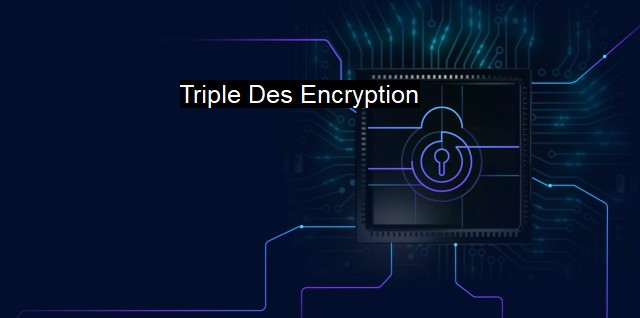What is Triple Des Encryption?
Triple DES Encryption: Enhancing Cybersecurity and Antivirus Protection in the Era of Increasing Cyber Threats
Triple DES encryption, also known as 3DES, is an encryption protocol that has its roots tied with the Data Encryption Standard (DES), a symmetric-key encryption standard widely employed throughout the 1980s and the 1990s. Triple DES was created to overcome the inherent vulnerabilities of the original DES algorithm and meet the rising demand for stronger data protection in an era of rapidly advancing cyber threats.Developed by IBM, DES became a widespread standard for safeguarding sensitive digital information. Despite its implementation, issues arose over time due to the short key length of 56-bits, which suggested the possibility of a brute-force attack; this is an attack where all potential key combinations are systematically checked until the correct one is found. As data processing technology became more advanced, attacks using this method became increasingly feasible, underscoring the need for an encryption standard with stronger security.
In order to enhance the security of the original DES without implementing a completely new system, the Triple DES algorithm was introduced. Effectively, 3DES applies the DES encryption algorithm three times to each data block. The basic principle of Triple DES encryption employs three individual 56-bit keys, resulting in an overall key length of 168 bits. The process involves three stages of the DES algorithm: the first stage encrypts the data with the first key, the second stage decrypts the first encryption with the second key, and the third stage encrypts the second decryption with the third key. Importantly, although the combined key length totals 168 bits, the actual security offered equates to 112-bit keys due to attacks aiming at its cryptographic structure.
Taking a closer look at its function maters, Triple DES is classified under symmetric encryption, meaning the same key is used for both the encryption and decryption processes. While this poses potential issues in key distribution and management, it also allows for the efficient encryption of large amounts of data, which is crucial for cybersecurity purposes.
The use of Triple DES encryption in cybersecurity and antivirus programs can't be overstated. Using this wave of encryption technology, these programs can protect a businesses' or an individual's online experience from phishing attacks, malware threats, and other breaches that hackers design to steal sensitive data.
Specifically, in a cybersecurity framework, Triple DES algorithms enhance the encryption of communication that flows between servers. It protects sensitive data while it's being transferred over networks, ensuring the data remains unreadable until it has safely reached its authorized destination. A significant application of Triple DES includes financial services. When you use a credit card to pay for goods online or withdraw cash from an ATM, Triple DES is often the underlying encryption standard safeguarding your transaction data.
Despite the robust protection that Triple DES offers, the technological leap in the last decade rendered 3DES somewhat undesirable compared to contemporaries like AES (Advanced Encryption Standard). The NIST (National Institute of Standards and Technology) has retired 3DES for use in block ciphers due to its vulnerabilities. AES, with its superior security level, faster computations, and flexibility in key and block length, is recommended as a more appropriate replacement for 3DES.
Despite its phase-out, understanding the nuances of Triple DES is vital in the context of cryptographic history and the broader study of cybersecurity. Triple DES serves as a reminder of how encryption algorithms must continuously evolve, adapting to ever-changing technology levels and escalating threats profile in the world of cybersecurity and antivirus.

Triple Des Encryption FAQs
What is Triple DES Encryption?
Triple DES Encryption is a method of encryption that uses three separate keys to encrypt and decrypt data multiple times. It is a secure encryption technique used in cybersecurity to protect sensitive information from unauthorized access.How does Triple DES Encryption work?
Triple DES Encryption works by applying the standard DES encryption algorithm three times with different keys. The data is first encrypted with one key, then decrypted with a second key, and finally encrypted again with a third key. This process is known as "encrypt-decrypt-encrypt" or "EDE". The result is a highly secure encryption method that is difficult to crack.Is Triple DES Encryption still used today?
Yes, Triple DES Encryption is still used today, although it has been largely replaced by more modern encryption techniques such as AES (Advanced Encryption Standard). However, Triple DES Encryption is still considered a secure encryption method and is used in situations where legacy systems or devices cannot be updated to use newer encryption methods.Is Triple DES Encryption vulnerable to attacks?
While Triple DES Encryption is still considered a secure encryption method, it is not immune to attacks. It is possible to break Triple DES Encryption using brute force attacks, which involve trying every possible key combination until the correct one is found. However, with a key length of 168 bits, it would take an impractical amount of time and resources to perform such an attack. In general, Triple DES Encryption is considered a strong encryption method that provides a high level of security.| | A | | | B | | | C | | | D | | | E | | | F | | | G | | | H | | | I | | | J | | | K | | | L | | | M | |
| | N | | | O | | | P | | | Q | | | R | | | S | | | T | | | U | | | V | | | W | | | X | | | Y | | | Z | |
| | 1 | | | 2 | | | 3 | | | 4 | | | 7 | | | 8 | | |||||||